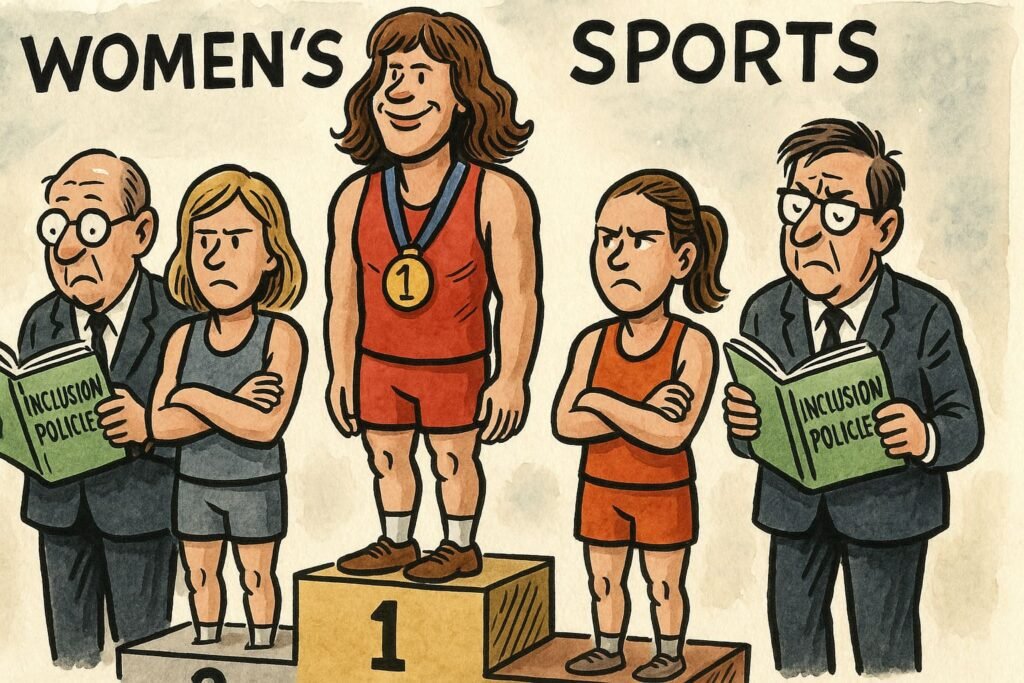Sports Policies on Trans Athletes Explained – Quick Guide
From Fair Play to Policy Chaos
Women’s sports exist for a reason: biology matters. But once gender identity entered the rulebooks, fairness got buried under bureaucracy. Every sports federation scrambled to write policies, with wildly different results. The outcome? Confusion for athletes, controversy for fans, and headlines for activists.
This quick guide cuts through the jargon to show where the rules really stand.
Table of contents
Global Sports Bodies
International Olympic Committee (IOC)
- For years, the IOC let biological males compete in women’s events if they lowered testosterone to below 10 nmol/L for 12 months.
- That rule allowed Laurel Hubbard to lift in Tokyo 2020 — and sparked global outrage.
- In 2021, the IOC quietly shifted responsibility to individual federations, washing its hands of the mess.
World Athletics
- In 2023, World Athletics banned trans women who had gone through male puberty from competing in the female category.
- Sebastian Coe, head of WA, called it a matter of “fairness for female athletes.” Translation: reality finally won a round.
World Rugby
- World Rugby became the first major federation to say it plainly: trans women can’t play elite women’s rugby.
- Why? Because a 100kg male-bodied tackler vs a 65kg female isn’t inclusion — it’s a hospital visit.
United States
- Allows trans women after one year of testosterone suppression.
- Result: uneven playing fields and endless lawsuits.
High School Athletics
- Connecticut became infamous when two trans sprinters dominated girls’ track events, taking titles and scholarships.
- Female athletes sued, arguing they’d been robbed of fair competition. The case is ongoing.
Case Studies
Laurel Hubbard – Weightlifting (Tokyo 2020)
- Met IOC’s testosterone rules, but retained male-bodied advantages in size and strength.
- Critics said it proved the policy was broken.
Hannah Mouncey – Australian Rugby
- Blocked from women’s leagues due to size and strength, even after transition.
- Sparked debate about safety vs inclusion.
- Two trans athletes dominated, winning multiple state titles.
- Female runners filed lawsuits, highlighting the clash between “inclusion” and fairness.
The Trend – Biology Makes a Comeback
After years of experiments, more federations are admitting the obvious: self-identification doesn’t erase male puberty. Testosterone tweaks can’t undo bone density, muscle mass, and lung capacity.
The shift is clear: sports are moving back toward biological sex as the standard. Not because of ideology, but because reality keeps scoring points.
Conclusion
Sports policies on trans athletes remain a patchwork, but the direction is obvious. Federations that tried inclusion at all costs are now rowing back. Why? Because fairness and safety aren’t optional extras in sport — they’re the whole point.
Until rules settle firmly on biological sex, women’s sport will stay caught between politics and physiology.
👉 For the bigger picture on why women’s sports exist in the first place, see our explainer: Fairness in Sport – Why Biology Still Matters.
👉 For the wider implications on women’s rights, read: Women’s Rights – Without Biological Sex, the Category “Woman” Loses Meaning.
Visit our Women & Biology Explainer Hub to see how law, sport, rights, and safeguarding all collide with ideology.
FAQ: Sports Policies on Trans Athletes
What are the IOC’s rules for trans athletes?
The IOC no longer sets universal rules. It leaves decisions to each sport’s federation.
Can trans women compete in women’s events?
It depends on the sport. Some (like rugby) ban it outright, others (like NCAA) still allow it under hormone rules.
Why do rules vary so much?
Because federations balance fairness, inclusion, and lawsuits differently. There’s no global standard.
What’s the main argument against inclusion?
That male puberty creates permanent physical advantages — unfair and unsafe for female competitors.
Are policies changing?
Yes. The trend is toward stricter rules based on biological sex, especially in elite competition.



